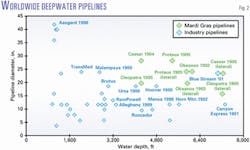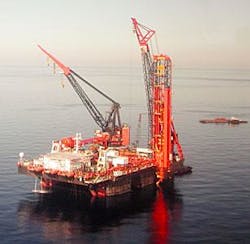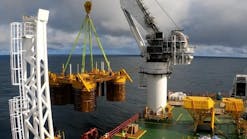Gulf project advances deepwater pipeline technologies
The Mardi Gras transportation system, operated by BP America Inc. and under construction in the Gulf of Mexico, is setting new standards for deepwater pipeline design and construction.
About 200 miles of the 485-mile system pipeline have been laid (Fig. 1). This includes the portion of the Okeanos pipeline laid by Shell Pipeline Co. LP from the Na Kika platform to the booster platform on Main Pass Block 260.
The first leg of the system to come on stream will be the Okeanos gas gathering system, slated for start-up in late 2003. This will be followed by the Caesar oil and Cleopatra gas lines in 2004, and the Proteus and Endymion oil pipelines the following year.
These segments and their commercial implications are the subject of next week's conclusion.
Fig. 2 illustrates the present extremes of deepwater pipelines around the globe, in terms of water depth and diameter. The pipeline closest to Mardi Gras's size and depth is the twinned Blue Stream natural gas lines, which crosses the Black Sea. That system, however, did not have the challenges of installing wye sled assemblies or other components in deepwater.
Mardi Gras 'firsts'
The system will have the largest pipelines ever laid at depths up to 7,300 ft and be able to transport more than 1 million b/d of oil and 1.5 bcfd of gas.
In addition, it claims an array of technical "firsts" for deepwater work, including:
- Deepest 28, 24, 20, and 16-in. pipe ever laid (5,350, 7,300, 6,000, and 7,300 ft, respectively).
- Largest diverless collet connectors at record depths (24-in., ANSI Class 1500 at 7,300 ft).
- Largest deepwater valves (28-in., full-bore ANSI Class 1500 in 4,000 ft of water).
- Deepest installation of piggable wyes (7,300 ft).
- Deepest dense-phase gas pipeline (7,300 ft, 16 in.).
- Deepest and largest steel catenary riser (SCR) ever installed (7,100 ft, 24 in.).
- Highest lay-barge tension ever planned for pipeline installation (450 tons).
The transportation system will move oil and gas from five key deepwater developments in which BP America is involved: Holstein, Mad Dog, and Atlantis oil and gas fields in the southeastern Green Canyon area, and Thunder Horse and Na Kika oil and gas fields in the southeastern Mississippi Canyon. These fields will begin production between late 2003 and 2006. (For related article, see p. 78).
Mardi Gras also will employ wye sled assemblies (WSAs), pipeline end terminations (PLETs), and pipeline jumpers at key deepwater connection points to facilitate the later addition of third-party production into the system (Fig. 3).
Key features of the system will be its availability to other producers and its access to multiple processing facilities and onshore pipelines all along the Gulf Coast, from Texas to Florida.
The large-diameter pipelines of the $1-billion Mardi Gras project will consist of five separate pipelines, named after New Orleans Mardi Gras parades, operated by BP America subsidiary Mardi Gras Transportation System Inc. and owned by BP and its various partners in the deepwater oil and gas developments:
- The 450,000-b/d Caesar Oil Pipeline will consist of 24-in. laterals and a 28-in. mainline of about 115 miles from the Holstein-Mad Dog-Atlantis area and will be owned by Caesar Oil Pipeline Co. LLC, comprised of BP America Inc., BHP Billiton Petroleum (Deepwater) Inc., Shell Pipeline Co. LP, and Union Oil Co. of California.
- The 500-MMcfd Cleopatra Gas Gathering System will consist of 16-in. laterals and a 20-in. mainline of about 115 miles from Holstein-Mad Dog-Atlantis area and will be owned by Cleopatra Gas Gathering Co. LLC, comprised of BP, BHP Billiton, Shell Gas Transmission, and Union Oil Co.
- The 1.2-bcfd Okeanos Gas Gathering System will consist of 20-in. laterals and a 24-in. mainline of about 100 miles from the Thunder Horse-Na Kika area and will be owned by Okeanos Gas Gathering Co. LLC, comprised of BP and Shell Destin LLC.
- The 28 in., 580,000-b/d Proteus Oil Pipeline, about 70 miles from the Thunder Horse semisubmersible platform and will be owned by Proteus Oil Pipeline Co. LLC, comprised of BP and ExxonMobil Pipeline Co.
- The 30-in. Endymion Oil Pipeline, carrying as much as 750,000 b/d 90 miles from the Proteus terminus on South Pass Block 89E to the Louisiana Offshore Oil Port (LOOP) at Clovelly, La., and will be owned by Endymion Oil Pipeline Co. LLC, comprised of BP and ExxonMobil.
System engineering
In early 2000, BP awarded Heerema Group's Intec Engineering division the engineering contract for the deepwater portion of the Mardi Gras transportation system.
The scope of the Intec contract was later extended to include procurement, construction, and commissioning support.
BP had several stringent requirements for design of the Mardi Gras system:
- The pipelines should be connected to the deepwater platforms with large-diameter SCRs capable of enduring the fatigue motions and loads that would be experienced at these water depths.
- The system must be capable of transporting record quantities of oil and gas at extreme water depths, which meant large-diameter line pipe would have to be fabricated to withstand enormous external pressures and installation stresses.
- The pipeline operator should be able to connect new discoveries into the system using diverless connections and without affecting base-load shipments.
- The entire system should be piggable by both intelligent and conventional pigs capable of traversing multi-diameter pipelines and asymmetric wyes.
Engineering design, procurement, and construction support for the 30-in. shallow water and onshore segments of the Mardi Gras transportation system were awarded to Paragon Engineering Services. Paragon was also awarded overall project management services.
SCR design
The Mardi Gras design team developed proprietary design techniques for the large-diameter SCRs that will be suspended from the spars and semisubmersibles on the development fields.
The major design challenge was preventing metal fatigue due to the combination of vessel motion and vortex-induced vibrations, which are caused by multiple current fluctuations at varying water depths.
Wye sled assemblies (WSAs; top photo) and pipeline end terminations (PLETs; bottom photo) along with pipeline jumpers are planned for key deepwater connection points so that third-party production can be added later into the system. WSAs and PLETs consist of a fabricated steel "mudmat" that supports a pipeline connection skid assembly of valves, collet connectors, and wyes on the sea floor (Fig. 3).
null
The pipewelds in the SCRs are the most critical sections.
Heerema is designing and Mardi Gras is testing the welding procedures that will be used on the project to verify that they will withstand the stresses these SCRs will endure (see accompanying sidebar on testing techniques.
The engineering contractor also helped design and procure the riser monitoring systems that will be installed on the SCRs. These systems will employ strain gauges plus current and angle monitors to track the motions of and the external stresses on the risers. By monitoring riser motions and stresses, BP will be able to manage riser life within safe guidelines.
Pipe design
BP and Intec designed the 16-28-in. deepwater pipelines for the Mardi Gras transportation system within stringent design constraints including flow assurance, survey and route selection, coatings, cathodic protection, material selection, span mitigation, buckle arrestors, and J-lay collars.
The pipelines were designed to be installed by S-lay vessel in intermediate water depths (less than roughly 3,700 feet) and by J-lay vessel in ultra-deep water. BP called on Sumitomo Metal Industries Ltd. to supply the line pipe for the project. Concerned about the record combination of wall thickness and diameter, BP undertook a $1-million testing program to determine the precise stress levels the pipe would be able to withstand, thereby fine-tuning and verifying the pipe design.
In addition, the company decided to heat-treat the manufactured pipe to recover some of the yield strength lost during the UOE manufacturing process. Because the pipe is heated during the internal and external coating process, equipment was installed to verify that it reached the necessary temperature for the requisite amount of time. Subsequent testing of the pipe indicated that the tensile strength was increased to a level that enabled BP to reduce the wall thickness slightly while maintaining pipe integrity.
Pipeline connections
To facilitate the connection of third-party production into the system in deep water, BP is employing a combination of subsea WSAs, PLETs, and pipeline jumpers.
Each WSA or PLET consists of a fabricated steel "mudmat" that supports a pipeline connection skid assembly of valves, collet connectors, and wyes on the sea floor. Each WSA weighs up to 120 tons.
A hinged-deployment yoke arrangement is incorporated into the design, and some WSAs will be equipped with two sliding mudmats actuated by a hydraulic motor acting on a screw-jack mechanism. The sliding sections will allow passage of the WSA into the J-lay tower on the J-lay installation vessel and, when extended, improve bottom stability.
For the jumpers that will enable BP to connect oil and gas flow into the connection point during hook-up of new production, Oil States HydroTech Inc. provided a diverless collet connector system. This scaled-up version of a well-proven system enables fast, ROV-assisted pipeline connections at ANSI 1500 class working pressures.
The collet connectors that will be used on the Mardi Gras transportation system represent a significant extension of existing technology, in terms of diameter (up to 28 in.).
The connector employs a metal seal with an external pressure rating greater than the external water pressure, an important feature for ultra-deepwater applications. If a situation requires completion components to be retrieved, the collet connector can be reversed and released with a simple ROV-operated procedure.
Fig. 4 shows an example of how the risers, WSAs, PLETs, and jumpers will be used in one of the field developments.
Vessel upgrade
null
The intermediate water depth pipe for the Mardi Gras system has already been laid by Allseas Group SA's Solitaire S-lay vessel (Fig. 5), and the deepwater sections are currently being laid by Heerema's SSIV Balder J-lay/heavy lift vessel (Fig. 6).
Heerema Group's SSIV Balder J-lay/heavy lift vessel, laying the deepwater sections, is one of only two J-lay vessels in the world of its size. Undertaking this work required major modifications to the vessel, which had previously been used only for heavy lift (Fig. 6).
null
The Balder is one of only two J-lay vessels in the world of its size.
The J-lay of 24-in. pipelines in 7,300 ft of water by Heerema will be another industry first. To undertake this work, Heerema made major alterations to the Balder, which had previously been used only as a heavy lift vessel.
With the installation of additional thrusters, a pipe handling system, and a J-lay tower, the Balder is now qualified to install large-diameter, deepwater pipelines. The chosen J-lay system installs hex joints (six 40-ft joints welded together) handled by way of collars welded onto each hex.
The J-lay tower can manage loads to 1,150 tons and will routinely handle tensions as high as 450 tons during normal pipelay. These numbers are two to three times those for typical pipelay vessels. The Mardi Gras systems' WSAs and PLETs are the largest and heaviest ever laid. Installation of the sleds causes the highest stresses experienced during pipelaying and requires unique operations involving both the J-lay tower and the vessel cranes.
To map the seabed through the treacherous and steep Sigsbee Escarpment, Mardi Gras used an autonomous underwater vehicle (AUV) that requires no cables and, because it runs on batteries, can remain submerged for 24-36 hr (Fig. 7).
null
Intec and Heerema developed special measures to keep the sleds within the constraints of the vessel, thereby reducing the high strains in the sag-bend during installation—another technological advance.
The technique was tested in installation trials before use on the Mardi Gras system (see testing sidebar).
Piggability
Another feature of the Mardi Gras system is the ability to use multidiameter intelligent and scraper pigs that will traverse the system's wyes and diameter changes. Mardi Gras undertook development of these pigs, which are hinged in the middle to enable them to move through pipe bends and wyes. Following extensive trials, custom made pigs will be manufactured.
The pig receivers for the Caesar and Cleopatra pipelines will be at a booster platform on Ship Shoal Block 332. The receivers for the Proteus and Endymion pipelines will be at Clovelly, and the Okeanos receiver on the shelf platform in Main Pass 260.
BP will also run specially designed pigs at commissioning and during maintenance to remove waxes and liquids from the lines.
Deepwater route survey
One of the largest technical hurdles for the Mardi Gras project team was selection of a suitable pipeline route for the Caesar and Cleopatra pipelines.
This is because, in order to reach the Atlantis floating production facility, the lines would have to traverse the Sigsbee Escarpment on the continental rise.
The heavily furrowed escarpment is as steep as 23-25° in some sections. BP decided to accept the risks of trying a new technology and, in an industry first, relied on an autonomous underwater vehicle (AUV) developed by C&C Technologies Inc. for deepwater seafloor mapping (Fig. 7).
The AUV presents a significant improvement over conventional survey technology. It requires no cables and, because it runs on batteries, it can stay submerged for 24-36 hr.
Operators can communicate with it using sonar, and the AUV is capable of making tight turns, saving time in multi-pass surveys.
In addition, data resolution is far better than with conventional towed-fish mapping.
After a few initial hiccups, the AUV turned out to be much faster than conventional surveys, and the resulting data were more easily manipulated and of higher quality.
Coincidentally, the AUV performing the Okeanos survey discovered a German submarine, the U-166, which had been lost during World War II. BP and partner Shell later funded an exploratory mission with an ROV to inspect the U-boat (OGJ, Aug. 20, 2001, p. 19).
The author
Rob Marshall ([email protected]), an employee of BP America Inc., is EPC manager (engineering, procurement, and construction-installation) of the Mardi Gras Transportation System. He has held project and operations positions in Canada, Norway, Russia, Egypt, and the US. Before joining the Mardi Gras project in 2000, his previous assignment was managing BP's initial Nile Delta gas developments as project manager for natural gas in Cairo. Marshall is a member of the Society of Petroleum Engineers and a registered engineer with the Association of Professional Engineers, Geologists and Geophysicists of Alberta. He holds a BSc (1979) in chemical engineering from the University of Alberta, Edmonton.









